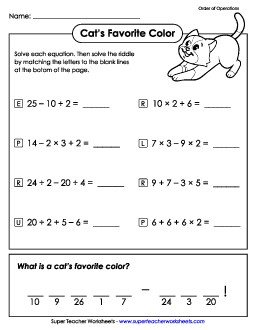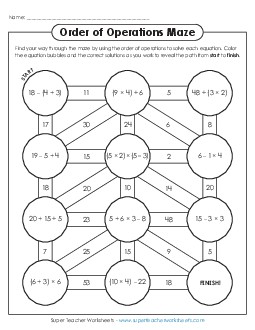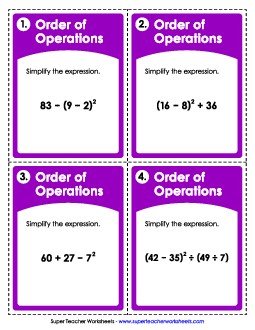Order of Operations

Order of Operations
(No Parentheses; No Exponents)
On these very basic Order of Operations worksheets and task cards, expressions and equations have no parenthesis and no exponents.
example: 4 × 7 + 8 - 2
Order of Operations
(Includes Parentheses; No Exponents)
These worksheets and task cards feature equations and expressions with parenthesis, but not exponents. Try a free worksheet with your class, or join STW to access all printables.
example: 3 × (4 + 5) - 7
Order of Operations
(Includes Exponents)
On these order of operations worksheets, students will evaluate expressions and solve equations with both parenthesis and exponents.
example: 3² ÷ (9 - 7)



The order of operations is an essential math skill taught in elementary and middle school, typically starting around fourth or fifth grade and continuing to be reinforced through higher grade levels. The order of operations refers to the specific sequence in which mathematical operations should be performed to correctly solve expressions with multiple steps. The acronym PEMDAS (Parentheses, Exponents, Multiplication and Division, Addition and Subtraction) is often used to help students remember the correct order. Teachers must be sure to stress that multiplication and division, as well as addition and subtraction, are solved from left to right. This means multiplication is not necessarily solved before division, and addition is not necessarily solved before subtraction. Following the PEMDAS rule ensures that math problems are solved consistently and accurately, which is especially important as students encounter more complex expressions involving multiple operations.
Teachers use a variety of methods and tools to introduce and reinforce the order of operations. Classroom strategies may include using mnemonic devices like "Please Excuse My Dear Aunt Sally" to help students memorize PEMDAS, practicing step-by-step problem solving on whiteboards, and working through interactive math games or puzzles. Visual aids, such as anchor charts that outline the PEMDAS sequence, and digital math platforms can also be helpful in engaging students and providing extra practice. Teachers often start with simple problems and gradually increase the difficulty, including expressions with parentheses, exponents, and multiple steps to ensure students fully understand the process.
Mastering the order of operations is critical for students as they advance in math, preparing them for more advanced topics like algebra, where multi-step problem solving is commonplace. Understanding and applying the order of operations allows students to accurately solve real-world problems, such as budgeting, calculating discounts, or working with formulas in science. This foundational skill not only builds confidence in one's math capability but also fosters logical thinking and problem-solving abilities that are valuable across various academic subjects. Super Teachers Worksheets provides free materials for students to practice order of operations at the beginner, intermediate, and advanced levels.






